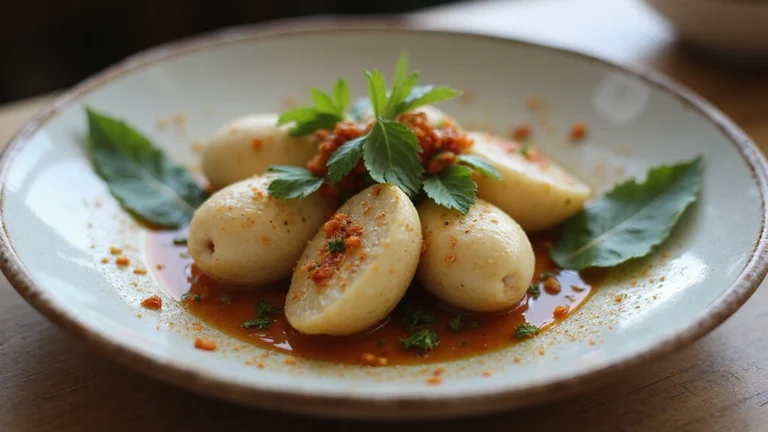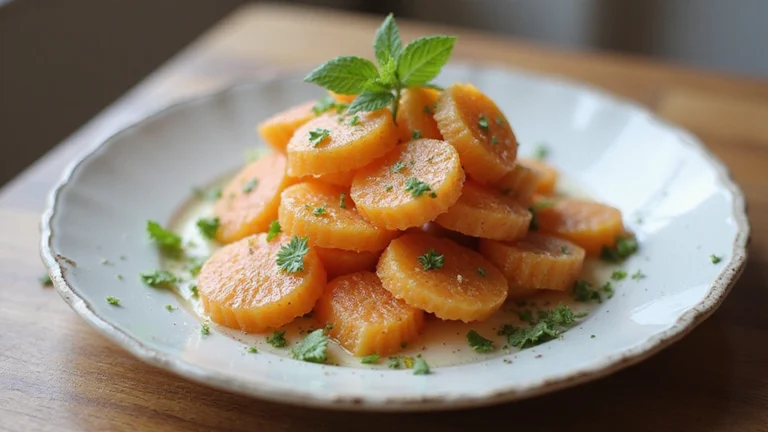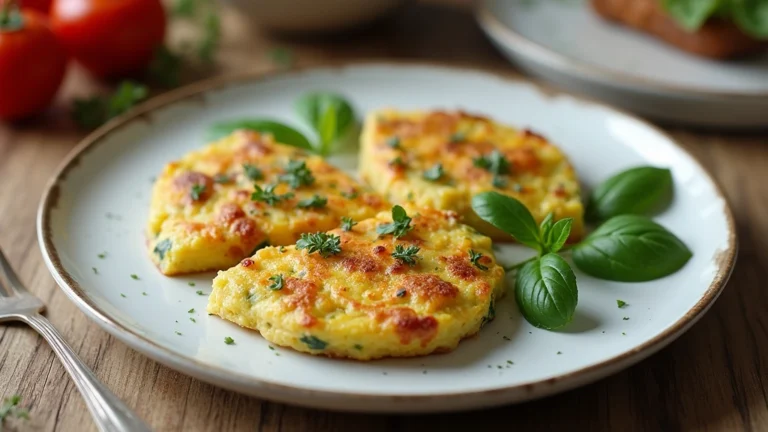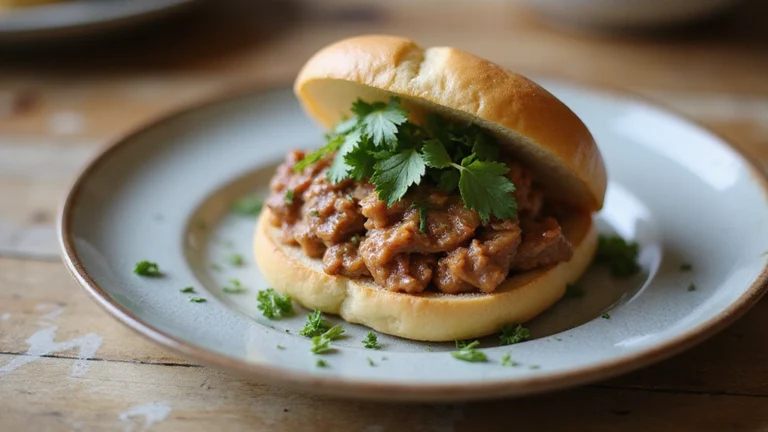
Have you ever tasted the unique sweetness of muscadine pie? This Southern classic transforms those thick-skinned wild grapes into a dessert that’ll transport you straight to a country porch swing on a warm summer evening.
Muscadine pie celebrates one of the South’s most beloved native fruits. These hardy grapes grow wild throughout the southeastern United States, ripening in late summer with their distinctive musky sweetness. Unlike regular grape pies, muscadine pie offers a bold, complex flavor profile that balances sweet and tart notes perfectly. The thick skins and seeds require a bit of preparation, but the result is well worth the effort.
Whether you’ve gathered muscadines yourself or found them at a local farmers market, this pie showcases their unique character in the most delicious way. With a flaky crust containing that vibrant purple filling, it’s a showstopper dessert that honors Southern culinary heritage.
What Are Muscadines?
Muscadines are native American grapes that grow wild throughout the southeastern United States. Unlike common table grapes you find in grocery stores muscadines are larger with thicker skins and contain seeds. These grapes typically measure between ¾ to 1½ inches in diameter featuring colors that range from bronze to deep purple-black when fully ripe.
The flavor profile of muscadines is distinctly different from other grape varieties. They offer a rich musky sweetness with complex notes that some describe as resembling tropical fruit wine or concentrated grape juice. Their high sugar content balances nicely with natural acidity making them perfect for pies and preserves.
Muscadine season runs from late August through October in most Southern states. You can forage these grapes from wild vines that often grow along fencerows and forest edges or purchase them at farmers markets and some specialty grocers during season. Many Southerners have fond memories of gathering these fragrant fruits during childhood adventures.
Two main varieties exist: the darker purple-black muscadines (often called “slipskins” because their flesh separates easily from the skin) and the bronze-colored scuppernongs which are technically a subspecies of muscadine. Both types work beautifully in pie recipes though they produce slightly different flavor profiles and colors in the finished dessert.
These grapes contain significantly higher amounts of antioxidants and resveratrol than conventional grapes making them not just delicious but nutritionally valuable as well. Their thick skins and seeds which require extra preparation work when baking contain most of these beneficial compounds.
Why You’ll Love This Muscadine Pie
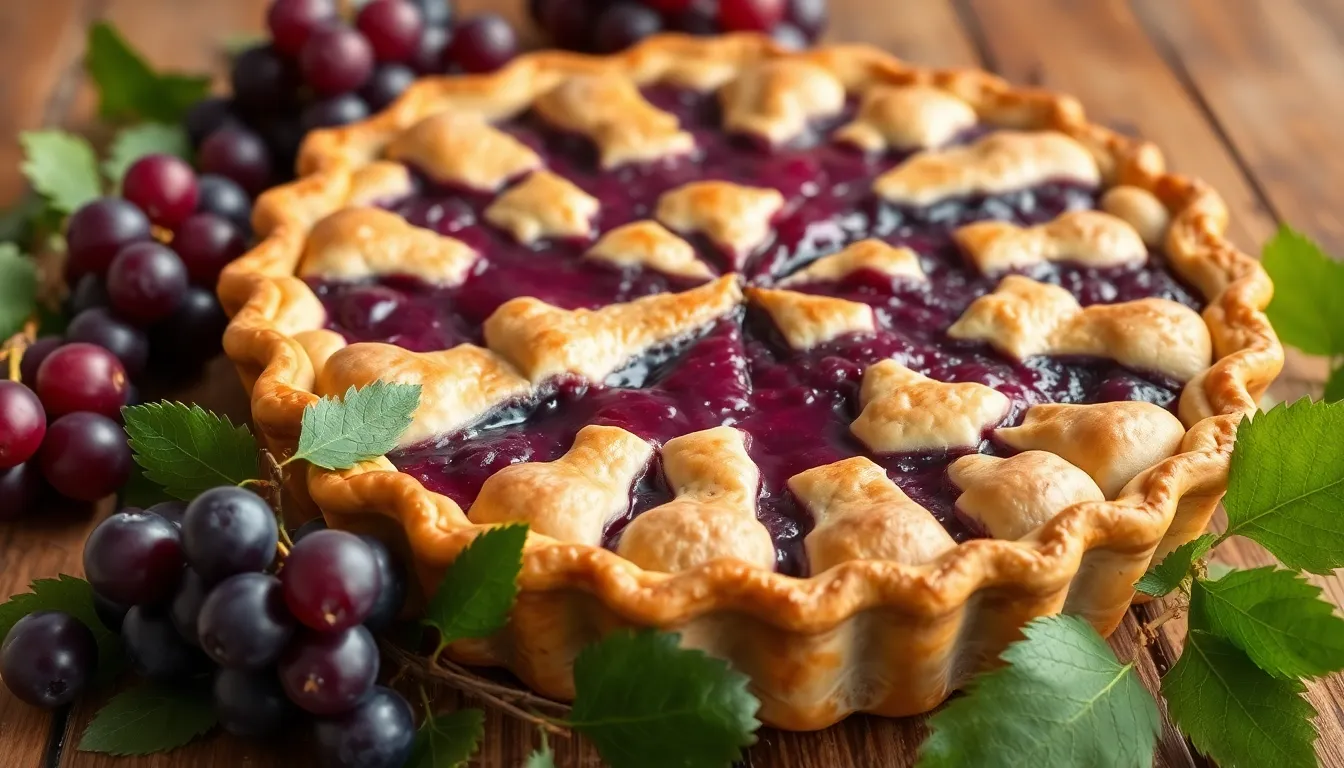
This muscadine pie transforms wild Southern grapes into a dessert that balances rustic charm with sophisticated flavor. The natural sweetness of ripe muscadines creates a filling that’s simultaneously jammy and bright with just the right amount of tartness to keep you coming back for another bite.
Your friends and family will be impressed by this unique dessert that showcases a truly American fruit often overlooked in modern cooking. The deep purple filling creates a stunning visual when sliced revealing the rich jewel tones that stand out beautifully against flaky golden crust.
Every forkful delivers complex flavor notes you simply can’t find in commercial grape varieties. The distinctive musky sweetness combined with tropical undertones makes this pie unlike anything available at bakeries or restaurants.
Making this pie connects you to generations of Southern cooks who have treasured these wild grapes. The process of transforming muscadines into pie filling allows you to participate in a culinary tradition dating back centuries.
Health conscious dessert lovers will appreciate that muscadines contain significantly higher levels of antioxidants and resveratrol than conventional grapes. Their nutritional benefits remain intact even after baking making this pie as virtuous as it is delicious.
Seasonal eating enthusiasts will enjoy how this recipe celebrates the brief late summer to early fall window when these special grapes reach their peak ripeness. The pie offers a perfect way to preserve and showcase this fleeting seasonal treasure.
Tools And Equipment Needed

Preparing a muscadine pie requires several essential kitchen tools to handle these unique Southern grapes efficiently. Gather these items before you begin to ensure a smooth baking process:
- Large colander – For washing and draining the muscadines thoroughly
- Sharp paring knife – Essential for cutting open the thick-skinned grapes
- Medium saucepan – For cooking down the muscadine filling
- Wooden spoon – For stirring the filling as it cooks and thickens
- Measuring cups and spoons – For accurate ingredient measurements
- 9-inch pie dish – Preferably glass or ceramic for even baking
- Rolling pin – For flattening your pie dough to the proper thickness
- Pastry brush – To apply egg wash for a golden crust finish
- Wire cooling rack – Allows air circulation under the pie after baking
- Food mill or fine-mesh strainer – Optional but helpful for separating seeds and skins if desired
- Pie weights or dried beans – For blind baking the crust if your recipe calls for it
- Aluminum foil or pie shield – To prevent crust edges from over-browning
A food processor can save time when making pie dough but isn’t strictly necessary. The most crucial tools focus on handling the muscadines properly since their thick skins and seeds require more preparation than conventional grapes. Your knife should be sharp enough to easily pierce through the muscadine skins without requiring excessive force.
Ingredients For Muscadine Pie
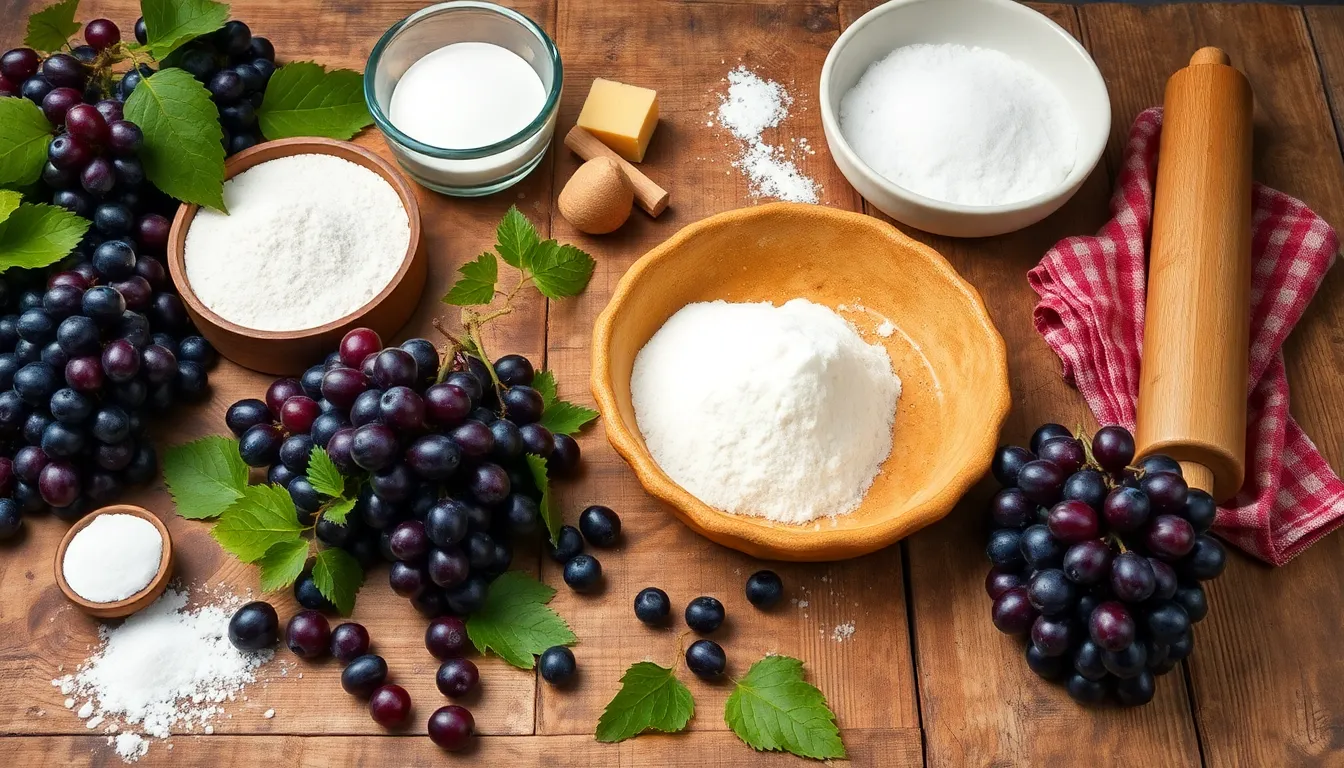
Creating this Southern classic requires exact ingredients that honor the unique qualities of muscadine grapes. Gather these components before you begin to ensure a smooth baking process.
For The Filling
- 6 cups muscadine grapes (about 3 pounds)
- 1 cup granulated sugar
- 3 tablespoons cornstarch
- 2 tablespoons fresh lemon juice
- ¼ teaspoon salt
- ½ teaspoon ground cinnamon
- ¼ teaspoon ground nutmeg (optional)
- 1 tablespoon butter, cut into small pieces
- 1 teaspoon vanilla extract
For The Crust
- 2½ cups all-purpose flour
- 1 tablespoon granulated sugar
- 1 teaspoon salt
- 1 cup cold unsalted butter, cubed (2 sticks)
- ¼ to ⅓ cup ice water
- 1 egg, beaten (for egg wash)
- 1 tablespoon coarse sugar or regular granulated sugar (for topping)
How To Prepare Muscadines
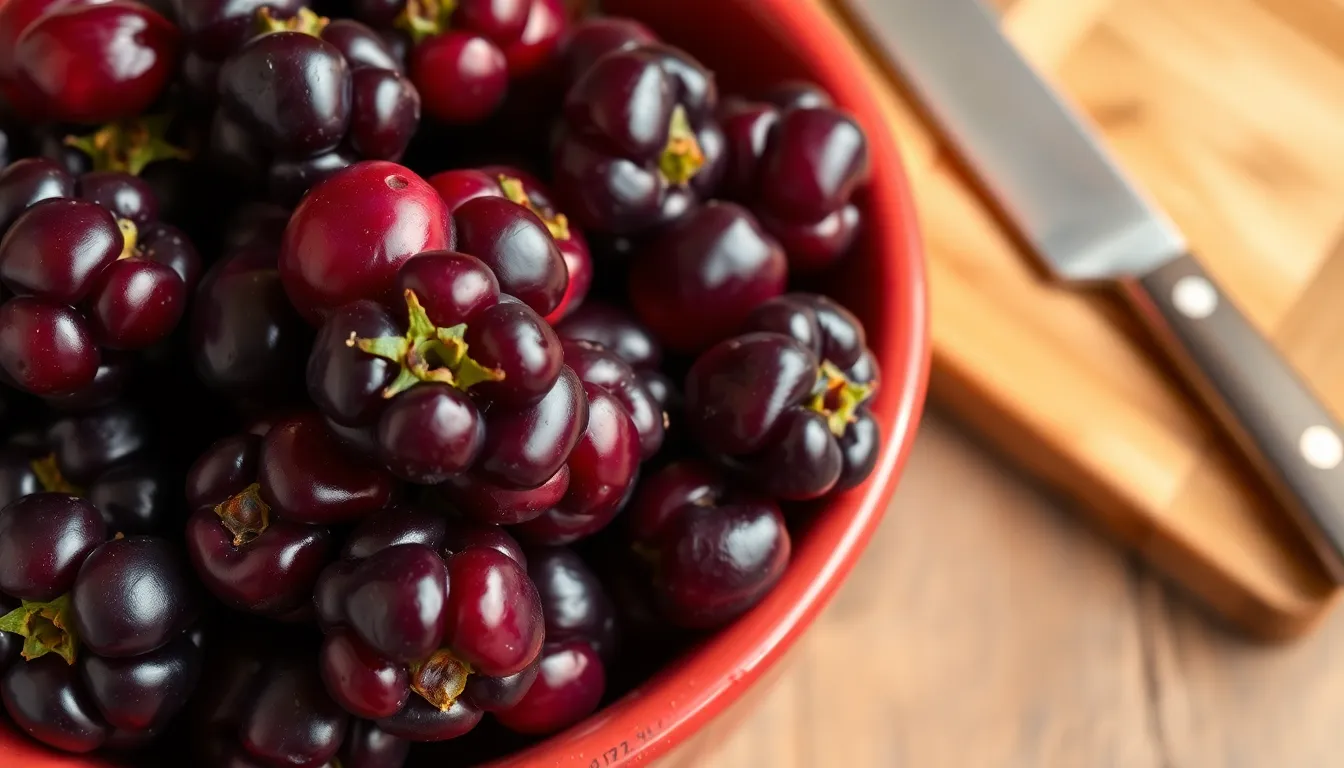
Properly preparing muscadines is essential to creating a delicious pie filling that showcases their unique flavor while addressing their thick skins and seeds. Follow these methods to transform raw muscadines into pie-ready fruit.
Washing And Sorting
Place your muscadines in a large colander and rinse them thoroughly under cool running water. Remove any stems, leaves, or debris that might be attached to the grapes. Examine each grape carefully, discarding any that show signs of mold, bruising, or overripeness. Sort the muscadines by size if desired, as similarly sized grapes will cook more evenly. Pat the cleaned muscadines gently with paper towels to remove excess moisture before proceeding with your recipe. For optimal flavor, use freshly harvested muscadines at the peak of ripeness when they yield slightly to gentle pressure and display vibrant color.
Removing Seeds And Skins
Cut each muscadine in half across its equator using a sharp paring knife. Squeeze the pulp from each half into a medium bowl, keeping the skins in a separate container. You’ll notice muscadine pulp contains several hard seeds that must be removed. Pour the collected pulp into a saucepan and heat it over medium-low heat until it softens, about 5 minutes. Press the warmed pulp through a fine-mesh sieve or food mill to separate the seeds from the juice and flesh. Discard the seeds and return the seedless pulp to your saucepan. The skins contain important flavor and color, so chop them into smaller pieces and add them back to the pulp mixture. This technique allows you to harness the beneficial compounds in the skins while ensuring they become tender during cooking. For a smoother texture, pulse the chopped skins in a food processor before adding them to the pulp.
Making The Perfect Pie Crust

A flaky homemade crust forms the foundation of an exceptional muscadine pie. The contrast between the buttery pastry and the sweet-tart grape filling creates a dessert experience that truly showcases these unique Southern fruits.
Mixing The Dough
Start with cold ingredients for the best results when making pie crust. Cut your cold unsalted butter into small cubes and return it to the refrigerator while you prepare the dry ingredients. Combine 2½ cups all-purpose flour with 1 tablespoon sugar and 1 teaspoon salt in a large bowl. Add the cold butter cubes to the flour mixture and use a pastry cutter or your fingertips to work it in until the mixture resembles coarse crumbs with some pea-sized pieces remaining.
Drizzle 4-6 tablespoons of ice-cold water over the mixture one tablespoon at a time. Gently toss with a fork after each addition until the dough begins to come together. You’ll know you’ve added enough water when the dough holds together when pinched between your fingers. Avoid overworking the dough which can develop too much gluten and result in a tough crust.
Divide the dough into two portions with one slightly larger than the other. Shape each portion into a disk about 1 inch thick. Wrap each disk tightly in plastic wrap and refrigerate for at least 1 hour or up to 2 days. This resting period allows the gluten to relax and the butter to firm up which eventually creates those desirable flaky layers.
Rolling And Shaping
Remove the larger disk from the refrigerator about 10 minutes before rolling to slightly soften it. Dust your work surface and rolling pin with flour to prevent sticking. Place the disk in the center of your floured surface and begin rolling from the center outward in all directions. Apply even pressure while rolling to create a uniform thickness of about ⅛ inch.
Rotate the dough a quarter turn after each roll to maintain a circular shape and prevent it from sticking to the surface. The finished circle should measure approximately 12 inches in diameter to fit a 9-inch pie plate with enough overhang for crimping. If the dough becomes too soft or sticky during rolling place it back in the refrigerator for 5-10 minutes to firm up.
Transfer the rolled dough to your pie plate by carefully folding it in half or draping it over your rolling pin. Gently press the dough into the bottom and sides of the plate without stretching it which can cause shrinkage during baking. Trim any excess dough leaving about a 1-inch overhang around the edges.
Pour your prepared muscadine filling into the bottom crust. Roll out the second smaller disk following the same technique to create the top crust. You can place it whole over the filling with vents cut for steam or create a lattice pattern for visual appeal. Fold the overhang of the bottom crust over the edges of the top crust and crimp decoratively using your fingers or a fork. Brush the top with an egg wash (1 beaten egg mixed with 1 tablespoon water) and sprinkle with sugar for a beautiful golden finish.
Preparing The Muscadine Filling
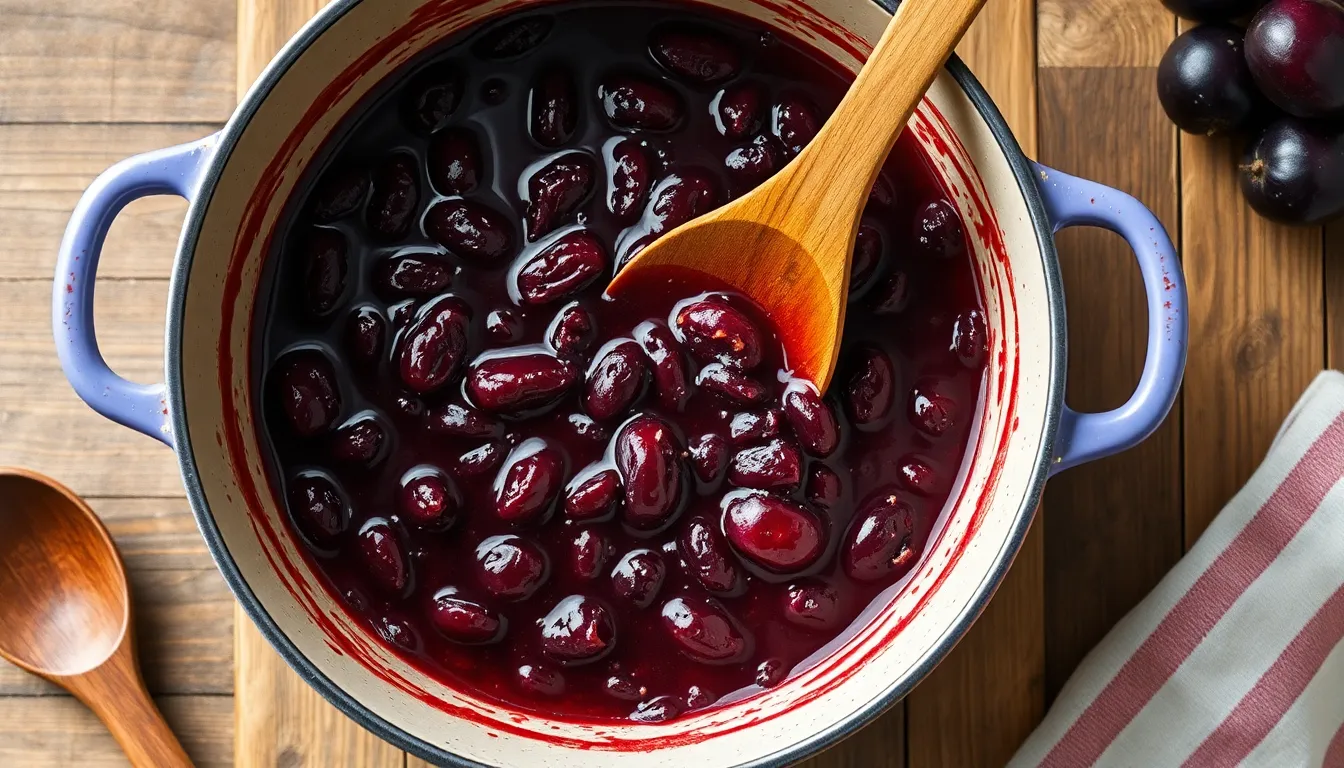
After preparing your muscadines by removing the seeds and separating the skins, it’s time to transform these unique Southern grapes into a luscious pie filling. This crucial step develops the deep flavors and perfect consistency that make muscadine pie so special.
Cooking The Muscadines
Transfer your prepared muscadine pulp to a medium saucepan over medium heat. Bring the mixture to a gentle simmer while stirring occasionally to prevent sticking. Allow the pulp to cook for about 10-15 minutes until it begins to break down and thicken slightly. The natural pectin in muscadines will help create a jammy consistency as they cook. Add the reserved skins back into the saucepan about halfway through the cooking process. These skins will soften during cooking while imparting their beautiful color and distinctive flavor to the filling. Stir the mixture gently but thoroughly to ensure even cooking and to prevent any scorching on the bottom of the pan. You’ll know the muscadines are properly cooked when they’ve released their juices and the skins have softened considerably.
Adding Sweeteners And Spices
Stir in 1 cup of granulated sugar to the cooked muscadines, adjusting the amount depending on the natural sweetness of your grapes. Sprinkle 3 tablespoons of cornstarch over the mixture and stir continuously to incorporate without clumping. Add 1 tablespoon of fresh lemon juice to brighten the flavor and balance the sweetness. Enhance the filling with ¼ teaspoon of salt to intensify the grape flavor and ½ teaspoon of ground cinnamon for warmth. Consider adding a pinch of freshly grated nutmeg for additional complexity if desired. Drop in 2 tablespoons of butter and stir until melted and incorporated. Remove the saucepan from heat and stir in 1 teaspoon of vanilla extract for aromatic depth. Allow the filling to cool slightly before adding it to your prepared pie crust. The filling should have a thick yet pourable consistency similar to a jammy preserves. Test the thickness by drawing a spoon through the mixture – it should leave a brief trail before slowly filling in.
Assembling Your Muscadine Pie
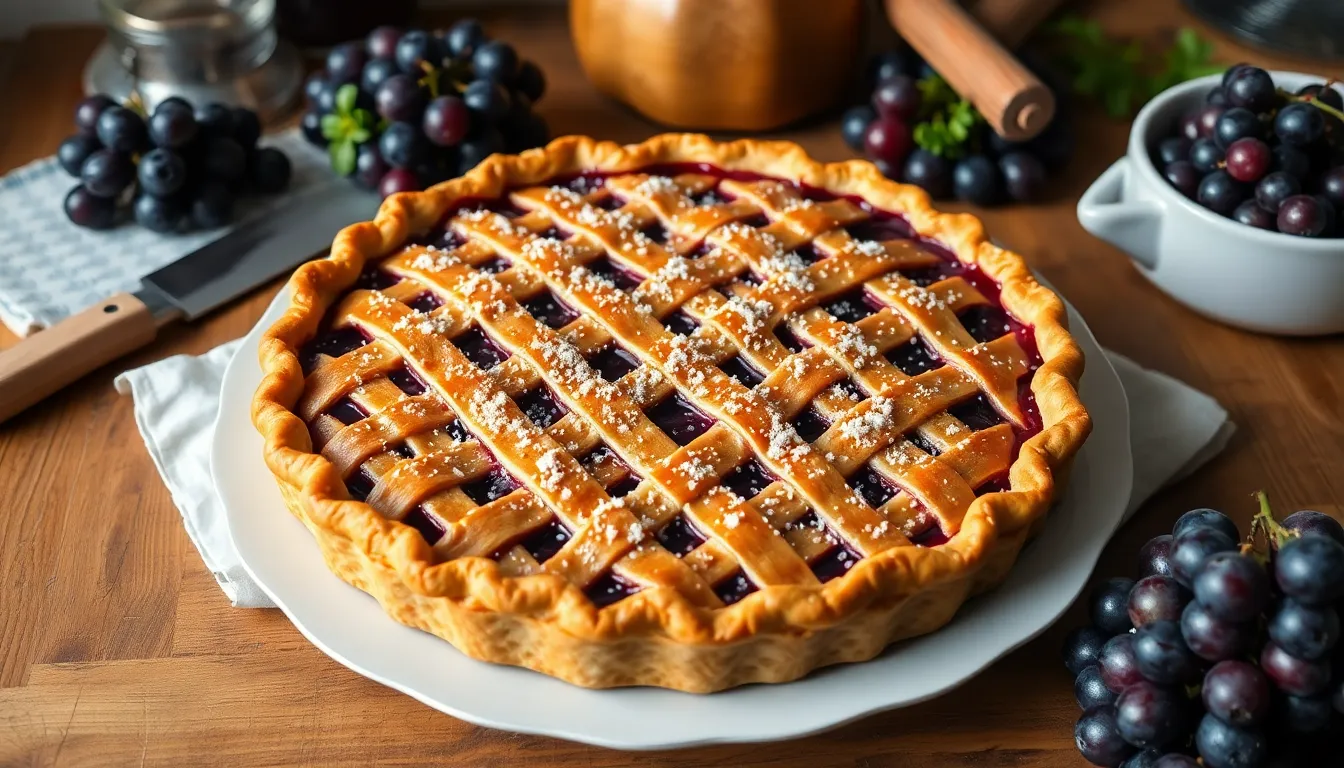
Now that you’ve prepared your crust and filling it’s time to bring your muscadine pie together. Pour your cooled filling into the bottom crust that’s already positioned in your pie plate. The deep purple mixture should spread evenly across the crust leaving about a 1/2 inch space from the edge.
Take your reserved top crust from the refrigerator and place it over the filling. If you’ve chosen a solid top crust trim any excess dough hanging over the edges with kitchen shears or a sharp knife. Leave about 3/4 inch overhang all around to create a proper seal. Fold the overhanging dough under the bottom crust edge and press together firmly.
For a decorative finish crimp the edges by pinching the dough between your thumb and forefinger at regular intervals around the perimeter. This creates the classic scalloped edge while ensuring your filling stays contained during baking.
If you’ve opted for a lattice top arrange your strips in a crisscross pattern over the filling. Start by laying parallel strips about 1 inch apart in one direction then fold back alternate strips halfway. Place a perpendicular strip across the unfolded strips then return the folded strips to their original position. Continue this weaving process until the entire surface is covered.
Before baking brush the top crust with egg wash using a pastry brush to ensure even coverage. This creates that signature golden brown shine. Sprinkle approximately 1 tablespoon of granulated or coarse sugar over the egg-washed surface for added sparkle and texture.
Don’t forget to cut vents in your top crust if you’re using a solid piece rather than a lattice design. Make 4-5 small slits about 1 inch long near the center using a sharp paring knife. These vents allow steam to escape during baking preventing your top crust from becoming soggy.
Place your assembled pie on a baking sheet to catch any potential overflow during baking. The baking sheet also makes it easier to transfer your pie in and out of the oven without disturbing your carefully crafted edges.
For picture-perfect results chill your fully assembled pie in the refrigerator for 15-20 minutes before baking. This final chill helps set the butter in the crust creating those desirable flaky layers while preventing the crust from shrinking during baking.
Baking Instructions
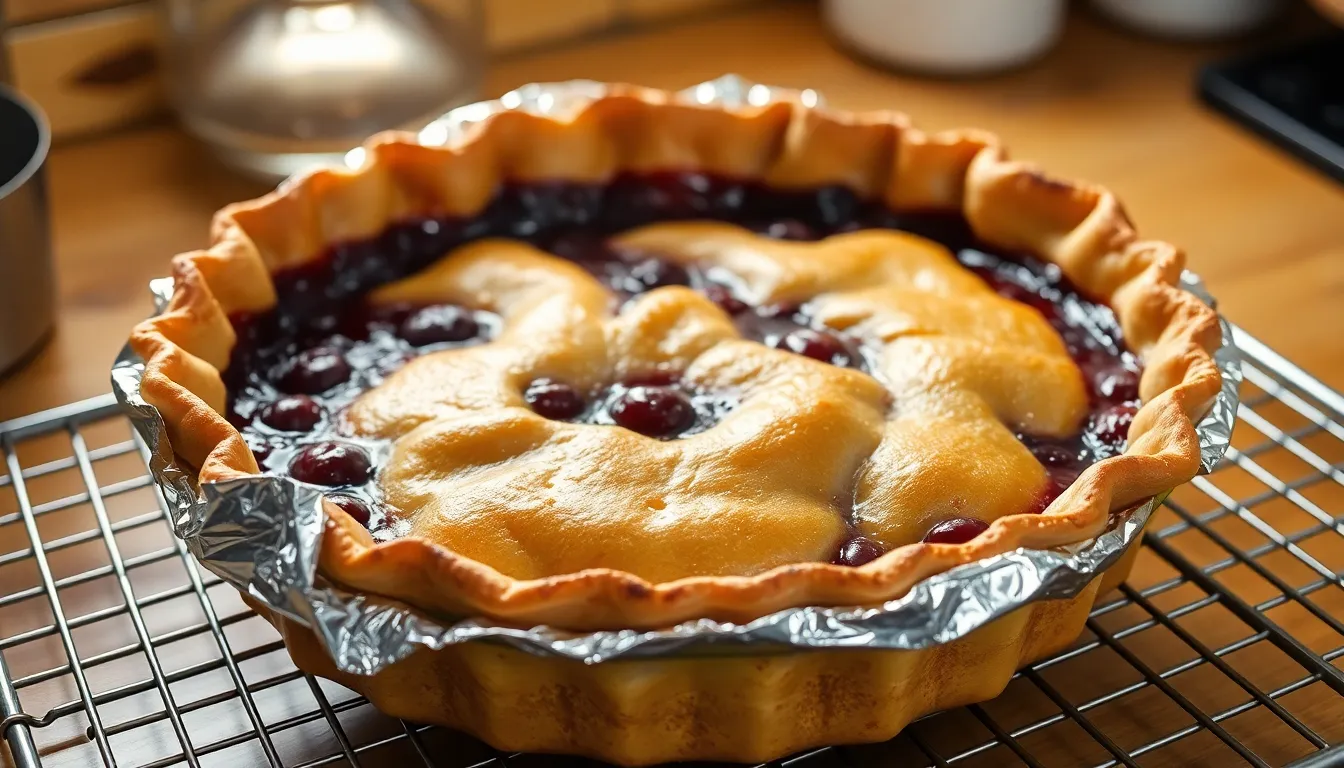
Once your muscadine pie is assembled and chilled, it’s time for the most rewarding part of the process: baking it to golden perfection. Follow these precise instructions to ensure your Southern delicacy bakes evenly and develops that irresistible caramelized fruit flavor.
Temperature And Timing
Preheat your oven to 425°F before you begin the baking process. Place your assembled muscadine pie on the middle rack and bake at this higher temperature for 15 minutes to set the crust quickly and create that initial golden color. Reduce the oven temperature to 350°F after the initial period and continue baking for 35-45 minutes more. This two-temperature approach ensures your crust becomes flaky and golden while allowing the filling enough time to bubble and thicken properly. Shield the edges of your pie with aluminum foil or a pie shield after about 20-25 minutes of total baking time if they’re browning too quickly. Remember to place a baking sheet beneath your pie to catch any potential filling overflow which prevents messy oven cleanups later. The total baking time typically ranges from 50-60 minutes depending on your exact oven and the moisture content of your muscadines.
How To Know When It’s Done
Your muscadine pie is ready when several visual and textural cues align perfectly. Look for a deeply golden brown crust with a rich caramel color that indicates proper baking. The filling should be visibly bubbling through the vents or lattice openings with thick, slow bubbles rather than rapid, watery ones. Insert a small knife or skewer into the center through one of the vents to check that the filling offers slight resistance but isn’t runny. The edges of the filling near the crust should appear set while the center maintains a slight jiggle when gently shaken. The aroma will intensify dramatically when the pie nears completion, filling your kitchen with the distinctive musky sweetness of muscadines. Allow your perfectly baked pie to cool completely on a wire rack for at least 4 hours before slicing to let the filling set properly. This cooling period is essential as the muscadine filling continues to thicken as it reaches room temperature, ensuring clean slices rather than a runny mess.
Serving Suggestions
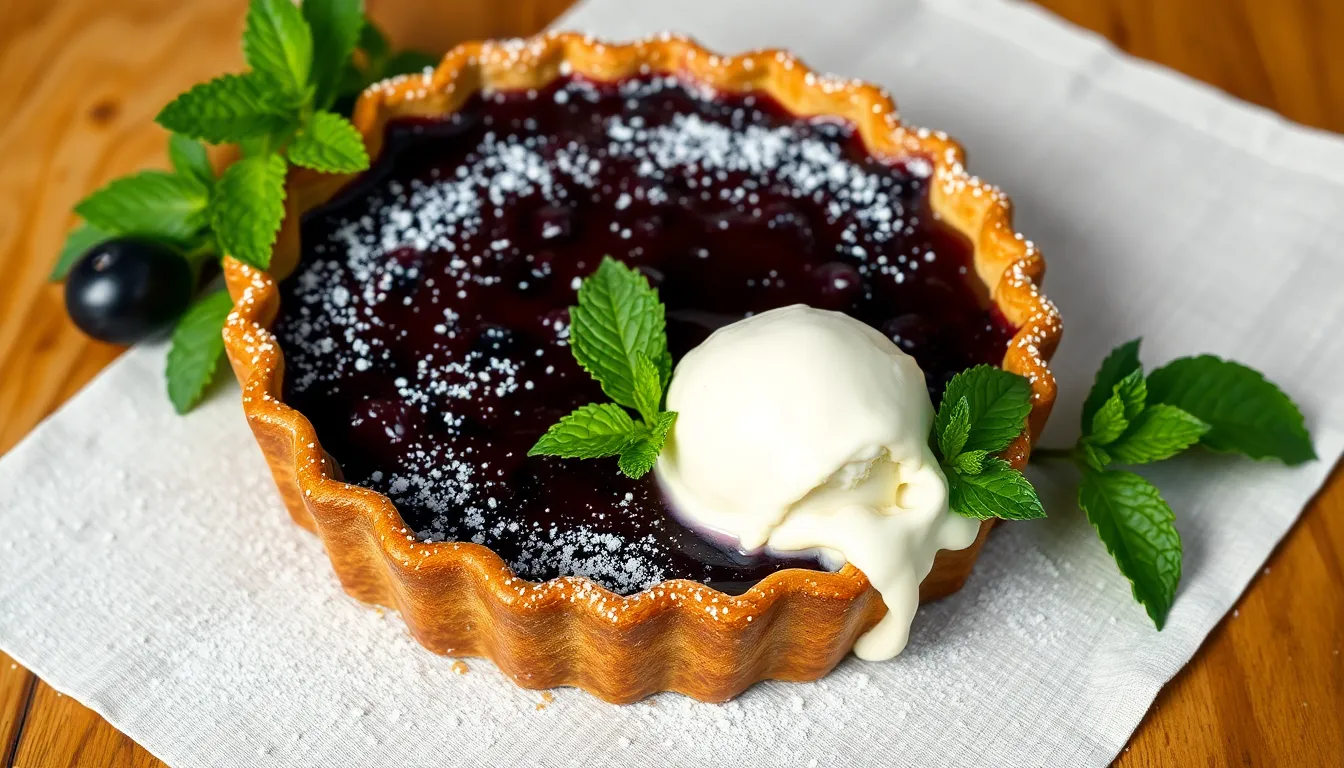
A perfectly baked muscadine pie deserves to be showcased in the most appealing way possible. Serve each slice slightly warm with a generous scoop of vanilla bean ice cream melting over the top for a classic Southern presentation. The creamy coolness of the ice cream complements the sweet tartness of the muscadines beautifully.
For a more decadent approach try pairing your muscadine pie with fresh whipped cream lightly sweetened with a touch of honey. The subtle floral notes in the honey enhance the natural grape flavor without overwhelming it.
Consider serving smaller slices as part of a Southern dessert board alongside pecan pralines and bourbon balls for an impressive after-dinner spread that celebrates regional flavors. This combination offers guests a taste of authentic Southern hospitality.
Morning gatherings call for muscadine pie with a dollop of Greek yogurt for a less sweet breakfast-appropriate option. The tanginess of the yogurt balances the rich filling and makes for a special weekend brunch treat.
Elevate your presentation by adding a light dusting of powdered sugar just before serving to create visual contrast against the deep purple filling. For special occasions garnish each plate with fresh mint leaves and a few fresh muscadines when in season.
Muscadine pie pairs wonderfully with beverages too. Serve alongside coffee with chicory for a New Orleans-inspired combination or sweet tea for a quintessential Southern experience. For adult gatherings a small glass of dessert wine or bourbon creates a sophisticated pairing that enhances the complex grape flavors.
Remember to allow the pie to cool completely before slicing if you want clean presentation-worthy pieces. Using a sharp knife dipped in hot water between cuts creates the neatest slices for serving.
Storage Tips
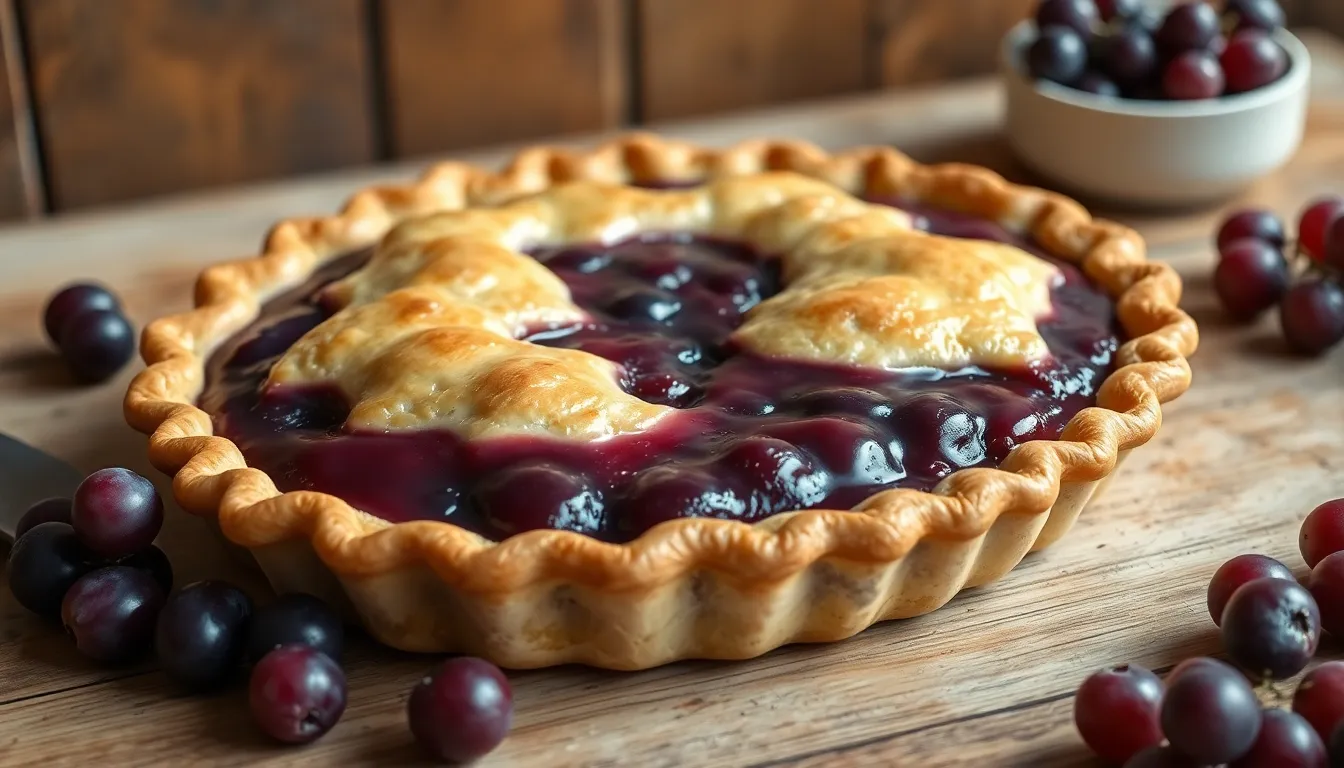
Properly storing your muscadine pie ensures you can enjoy its unique Southern flavors for several days after baking. Freshly baked muscadine pie will keep at room temperature for up to 2 days when covered loosely with foil or a pie dome.
Store your pie in the refrigerator for extended freshness. Simply cover it with plastic wrap or place it in an airtight container where it will remain good for up to 5 days. The filling may continue to set and thicken slightly during refrigeration which can enhance the jammy texture.
Muscadine pie freezes exceptionally well for longer storage needs. Allow the pie to cool completely before wrapping it tightly in a double layer of plastic wrap followed by aluminum foil. Label with the date and freeze for up to 3 months without important quality loss.
When ready to enjoy frozen muscadine pie allow it to thaw overnight in the refrigerator. Revive the crust’s flakiness by warming individual slices in a 350°F oven for 10-15 minutes before serving.
The natural preservative qualities in muscadines’ high acid content help maintain flavor during storage better than many fruit pies. Their unique chemical composition means the vibrant grape flavor remains relatively stable even after freezing.
Consider portioning your pie before freezing if you prefer enjoying single servings. Cut the cooled pie into slices wrap each piece individually and store in a freezer-safe container for convenient access to this seasonal treat year-round.
Muscadine Pie Variations
Muscadine pies offer wonderful opportunities for customization based on your preferences and available ingredients. These variations highlight different textures and presentations while maintaining the distinctive muscadine flavor profile.
Double Crust Version
The traditional double crust muscadine pie features both a bottom and top layer of pastry that completely encloses the filling. Begin by preparing your standard pie dough recipe, dividing it into two portions with one slightly larger than the other. Roll out the larger portion for your bottom crust, fitting it into your pie plate with about a half-inch overhang. After adding your prepared muscadine filling, roll out the second portion and place it directly over the filling. Trim the excess dough, leaving about a half-inch overhang, then fold the edges under and crimp decoratively. Cut several vents in the top crust to allow steam to escape during baking. For an attractive finish, brush the top with egg wash and sprinkle with coarse sugar before baking. This classic approach produces a pie with balanced textures and a beautiful golden dome that showcases the traditional Southern pie-making technique.
Crumble Top Option
A crumble top muscadine pie offers a delightful textural contrast to the jammy filling. Prepare your muscadine filling and bottom crust as normal, but instead of covering with a second layer of pastry, top with a buttery streusel mixture. Make the crumble topping by combining 1 cup all-purpose flour, ½ cup brown sugar, ½ cup granulated sugar, 1 teaspoon cinnamon, and ¼ teaspoon salt in a bowl. Cut in ½ cup cold butter using a pastry cutter until the mixture resembles coarse crumbs. Sprinkle this generously over your muscadine filling, covering it completely. Bake until the crumble turns golden brown and the filling bubbles around the edges. This version allows more of the vibrant purple muscadine color to show through while adding a contrasting sweet crunch that complements the tartness of the grapes. Many bakers prefer this option when showcasing particularly colorful muscadine varieties or when looking for a less time-consuming alternative to a lattice top.
The Perfect Southern Dessert Experience
Muscadine pie stands as a testament to Southern ingenuity and appreciation for local bounty. This remarkable dessert transforms humble wild grapes into a celebration of regional flavor that can’t be replicated with any other fruit.
When you bake this pie you’re not just creating a dessert – you’re preserving a piece of Southern heritage. The effort of preparing muscadines yields rewards far beyond the typical pie experience with complex flavors that dance between sweet jammy richness and bright acidity.
Whether you choose a double crust or crumble top your muscadine pie will bring a touch of Southern charm to any table. So grab your basket next muscadine season and discover why this special pie has captured Southern hearts for generations.
Frequently Asked Questions
What are muscadines?
Muscadines are native American grapes that grow wild throughout the southeastern United States. They’re larger than common table grapes (¾ to 1½ inches in diameter) with thicker skins and seeds. They range in color from bronze to deep purple-black when ripe and have a distinctive musky sweetness with complex flavor notes. The two main varieties are the darker purple-black muscadines and the bronze-colored scuppernongs.
When is muscadine season?
Muscadine season runs from late August through October in the southeastern United States. This short seasonal window represents the perfect time to harvest these unique wild grapes at their peak ripeness. Many Southerners have fond memories of foraging for these grapes during this fall period, when the fruits develop their characteristic rich, musky sweetness.
Are muscadines healthy?
Yes, muscadines are exceptionally nutritious. They contain higher amounts of antioxidants and resveratrol than conventional grapes. Most of these beneficial compounds are found in the skins and seeds. Even after baking in a pie, these health-promoting elements remain intact, making muscadine pie a relatively healthier dessert option that offers complex flavors while providing valuable nutrients.
How do you prepare muscadines for pie?
To prepare muscadines for pie, wash and sort the grapes first. Then, cut each grape in half and squeeze the pulp from the skins (save both). Cook the pulp to soften it, then strain out the seeds. Combine the seedless pulp with the reserved skins, sugar, cornstarch, lemon juice, salt, and spices. Cook until the mixture thickens to a jammy consistency before using it as pie filling.
What makes muscadine pie different from regular grape pie?
Muscadine pie offers a more complex flavor profile than regular grape pie. The muscadines’ thick skins and unique musky sweetness create a bold taste that balances sweet and tart notes with wine-like complexity. The pie filling has a rich, jammy texture with deeper color and more concentrated grape flavor. It’s also a celebration of Southern culinary tradition that showcases a truly American fruit not commonly found in commercial products.
How long should muscadine pie cool before serving?
Allow muscadine pie to cool for at least 4 hours before slicing. This cooling period is crucial as it allows the filling to set properly, ensuring clean slices when served. If you cut into the pie while it’s still warm, the filling may run and create a messy presentation. The patience required for cooling is rewarded with perfectly set slices that maintain their shape.
Can muscadine pie be frozen?
Yes, muscadine pie freezes well for up to 3 months. Allow the baked pie to cool completely, then wrap it tightly in plastic wrap followed by aluminum foil or place in a freezer-safe container. For convenience, consider pre-slicing the pie before freezing. Thaw overnight in the refrigerator and warm slightly before serving for the best flavor and texture.
What’s the best way to serve muscadine pie?
Serve muscadine pie warm with vanilla bean ice cream or fresh whipped cream sweetened with honey. For a Southern dessert board, pair smaller slices with pecan pralines and bourbon balls. For breakfast or brunch, serve with Greek yogurt for a less sweet option. Garnish with powdered sugar and fresh mint leaves for visual appeal. Pair with coffee, sweet tea, or a dessert wine.
Can I use store-bought crust for muscadine pie?
Yes, you can use store-bought crust for muscadine pie if you’re short on time. While homemade crust delivers superior flavor and texture, a quality pre-made crust works well with the distinctive muscadine filling. If using store-bought, follow the package instructions for blind baking (if required) and be mindful of potentially shorter baking times as commercial crusts may brown more quickly.
Are there different variations of muscadine pie?
Yes, the two main variations are traditional double crust and crumble top. The double crust version features pastry on both bottom and top, creating a classic pie appearance. The crumble top option combines the traditional bottom crust with a sweet, buttery streusel topping that provides textural contrast to the jammy filling. Both variations maintain the distinctive muscadine flavor while offering different textural experiences.
